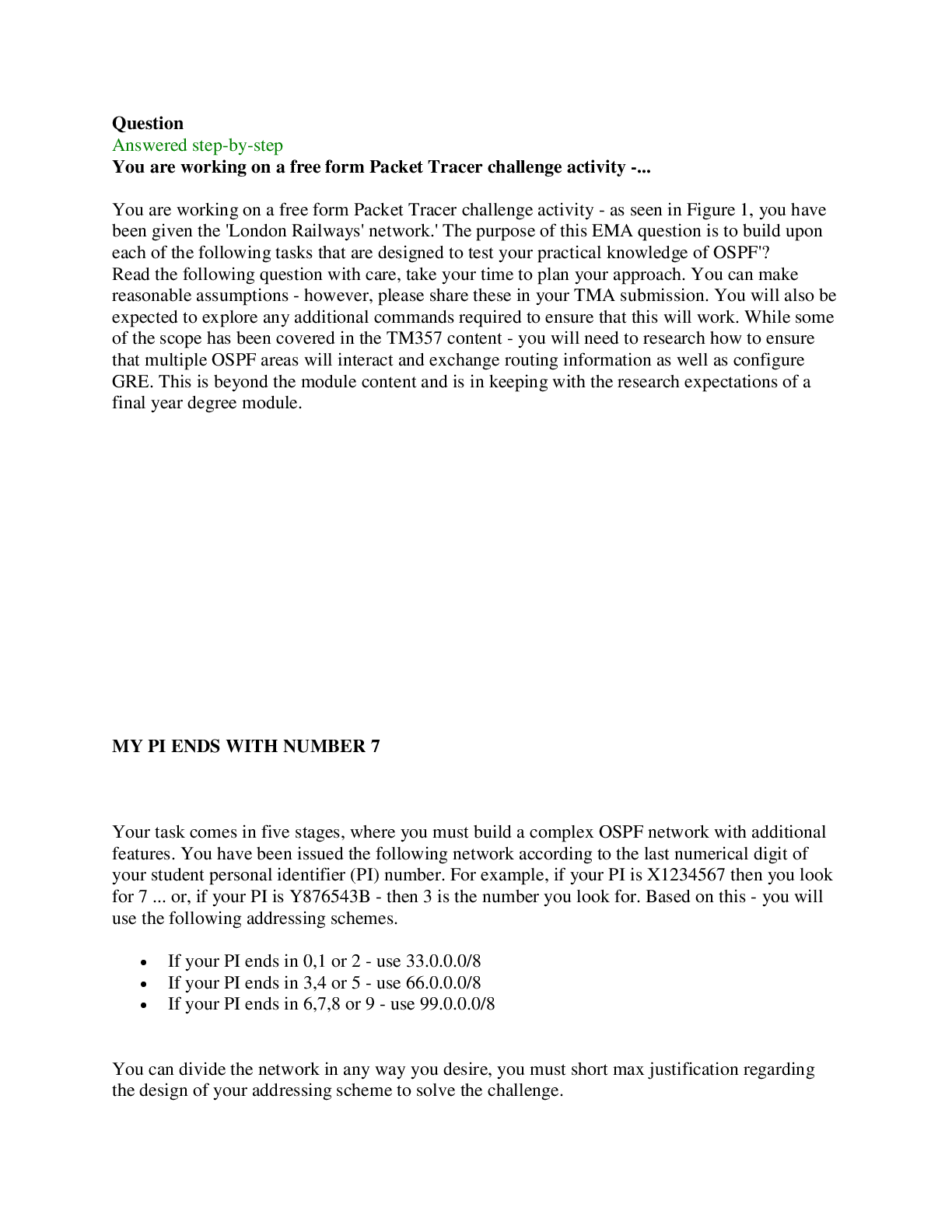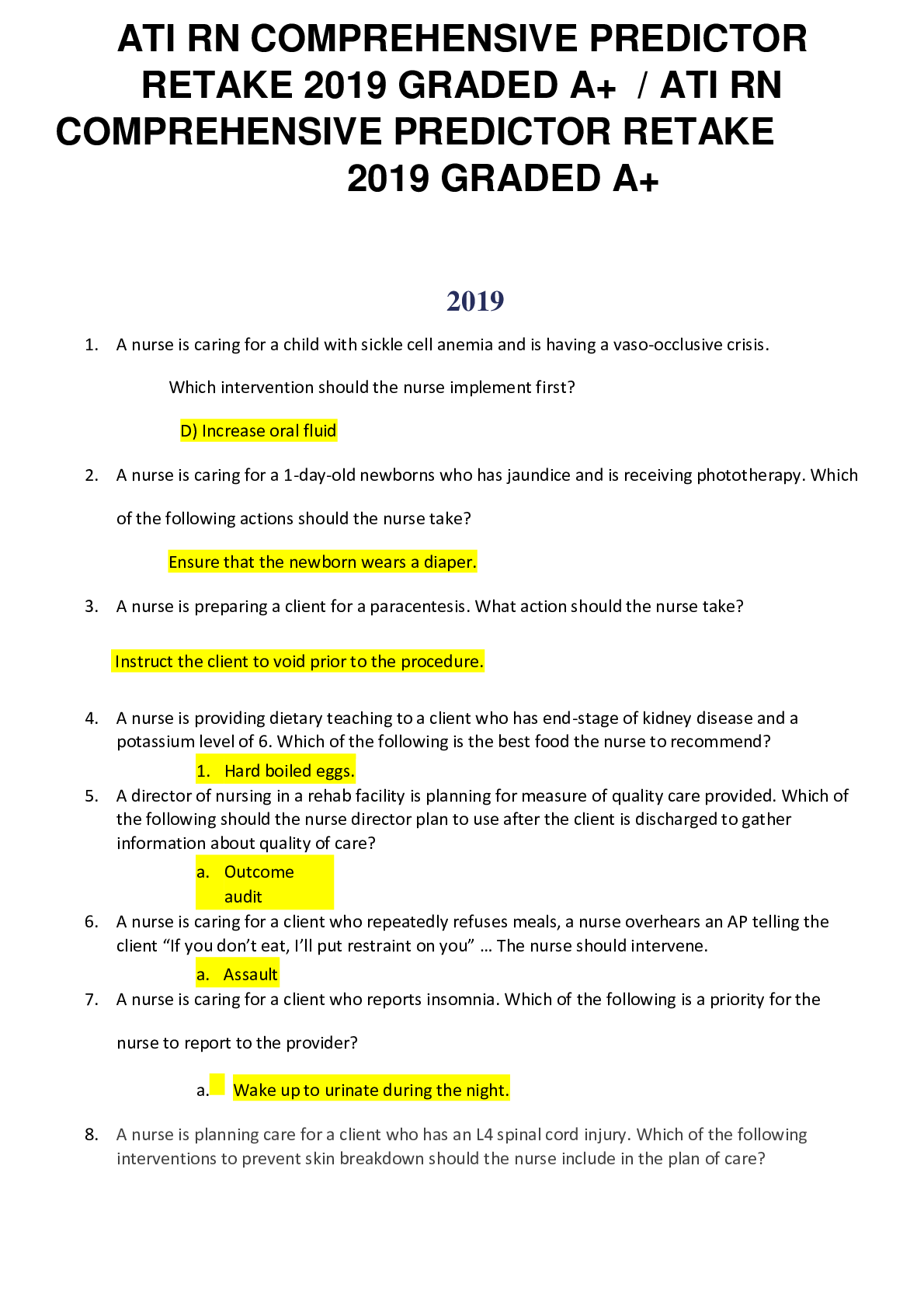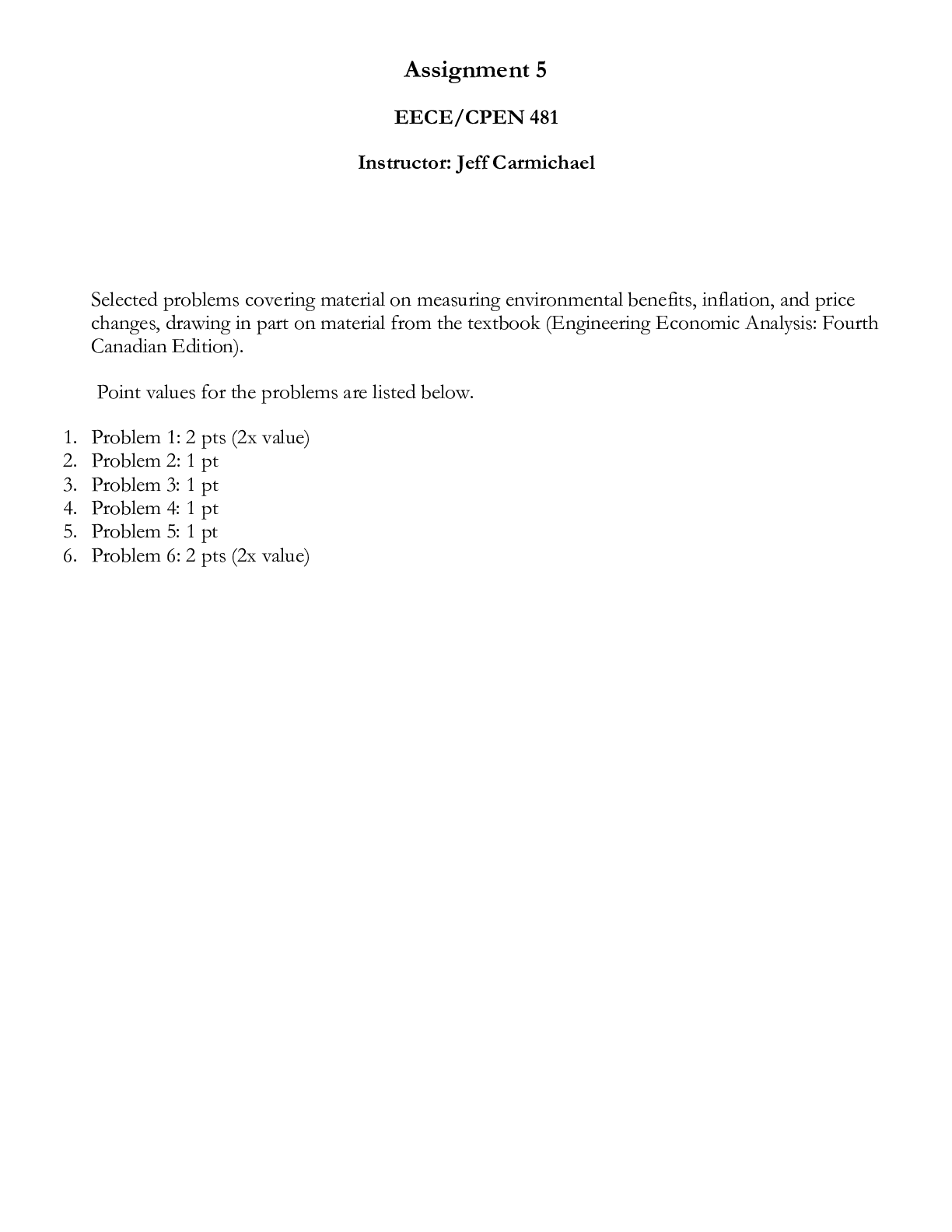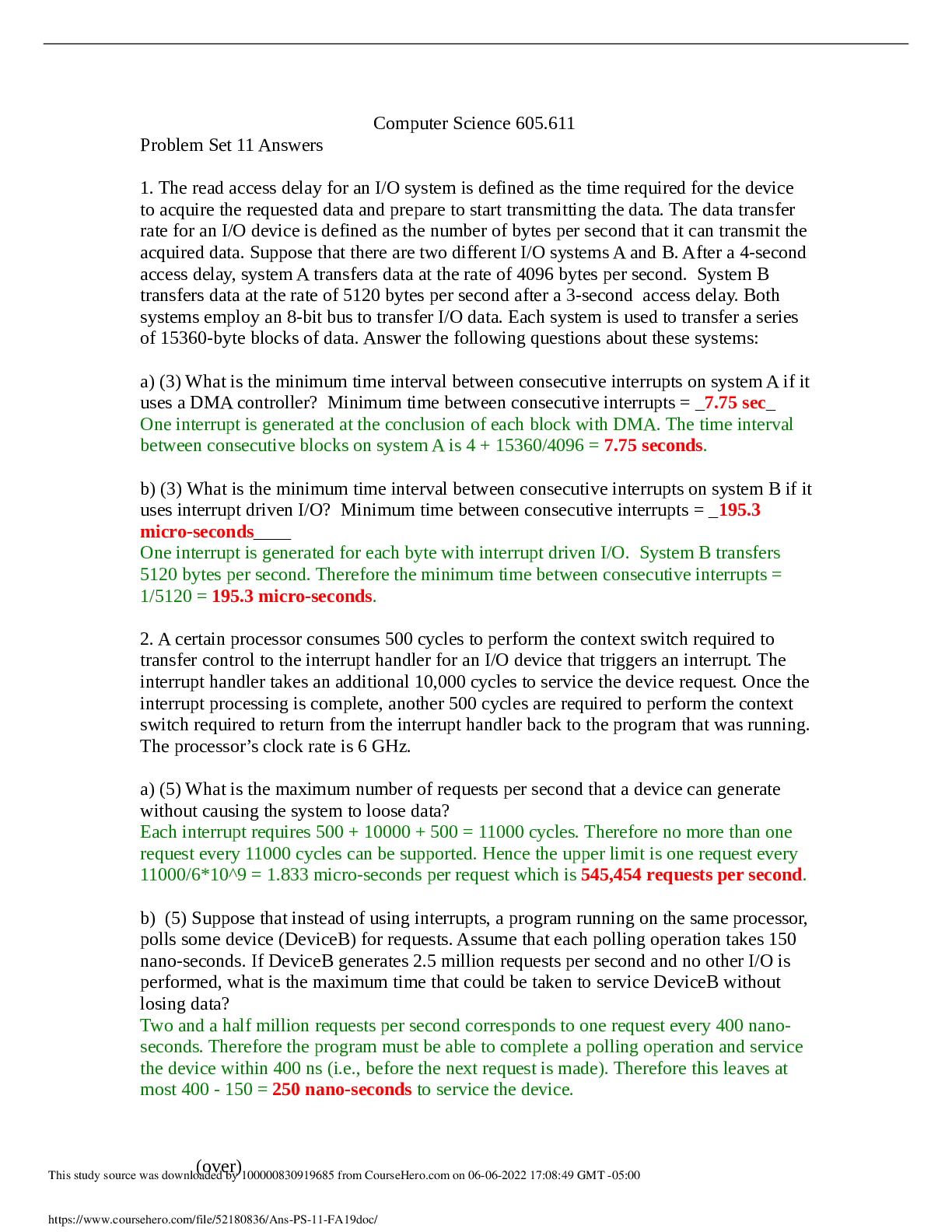Geography > QUESTIONS & ANSWERS > University Of Georgia GEOG 1111_ INTRO TO PHYSICAL GEOGRAPHY LAB. CAMPUS GEOMORPHOLOGY FIELD TRIP. P (All)
University Of Georgia GEOG 1111_ INTRO TO PHYSICAL GEOGRAPHY LAB. CAMPUS GEOMORPHOLOGY FIELD TRIP. Project Report Q&A.
Document Content and Description Below
GEOG 1111, Spring 2017 Class CAMPUS GEOMORPHOLOGY FIELD TRIP Instructor: Stan Hopkins Assigned: March 02, 2017 Due Date: March 21, 2017 or before Directions: This assignment involves a self-guided t... our of several exhibits and points of interest in the Geography-Geology (G-G) building, and around campus. Since the directions are geared toward starting on the third floor of the G-G Bldg., I suggest that you start there. Otherwise, the directions may be a little confusing, but not incomprehensible. (60 pt total) (It should take you about 45 - 60 minutes to complete.) Place your answers on these sheets or on a separate sheet of paper. PLEASE DO NOT WRITE IN ANY WAY ON ANY OF THE MAPS, POSTERS, OR OTHER DISPLAY ITEMS. I. Walk up the main stairs to the third floor of the G-G building. At the head of the stairs you will encounter a large rock that was collected from the Pennington Formation. This particular sample is sandstone - a common sedimentary rock type. Read through the description to determine when the sediment that comprises this rock was deposited. The texture that you see on the exposed surface of this rock is the fossilized burrows of small marine organisms. 01. During what PERIOD of geologic time was the sediment of the Pennington Formation formed? (Note: Use the geologic time scale found on the class website.) 02. What specific term applies to the preserved burrows, tracks, trails and nests of the animals or plants? II. Read the information about the sample of Athens gneiss to the left of the Pennington Formation. 03. What type of rock (sedimentary, igneous or metamorphic) is Athens (biotite) gneiss? III. Go through the glass doors in front of you and there is a large display case. The case contains examples of several minerals. Take a look at the mineral samples. The shapes are a function of the crystalline structure of the minerals. Look around in the case at some of the samples. 04. What is the chemical formula of the minerals zircon, calcite and chalcopyrite? IV. Turn right and walk down the hallway and, you will see a large map mounted on the right wall of the hallway. The map is titled, "WORLD MAP OF VOLCANOES, EARTHQUAKES, AND PLATE TECTONICS." Plate boundaries are marked, some in red. Arrows indicate the direction and spreading rate (in centimeters per year) of the plates away from a mid-oceanic ridge. DO NOT MARK OR WRITE ON THE MAP!!!! 05. What type of plate boundary (convergent, divergent, or transform) exists between the Nazca and South American Plates? (You may want to refer to you notes to help answer this question.) 06. What type of plate boundary (convergent, divergent, or transform) exists between the Pacific and North American Plates in southern California? (You may want to refer to you notes to help answer this question.) 07. What type of plate boundary (convergent, divergent, or transform) exists between the African and South American plates? (You may want to refer to you notes to help answer this question.) V. Turn right and walk down the hallway and, you will see a large, 2-section slab of greenish pillow basalt mounted on the right wall of the hallway. Look over the description of this formation located on the left-hand side of the slab. The greenstone package was dated using Rb-Sr whole rock isochrons. 08. What is the suggested age, in millions of years (Ma), of this formation? VI. Walk down the hallway to your left and around the corner. You should see 2 geologic cross-sections of areas in the southwestern US, one on the right and one on the left. Examine the cross-sections. This area is dominated by sedimentary rocks created from deposits laid down millions of years ago when the area was covered by vast expanses of ocean and ocean water bodies. PLEASE DO NOT MARK OR WRITE ON THE POSTER CROSS-SECTION!!!! 09. What is the age (geologic PERIOD) of the Callville Limestone? 10. What is the geologic PERIOD of the Cedar Mesa Sandstone? VII. Also in this hallway are 2 posters of prehistoric animals, Age of Mammals & Age of Reptiles. Answer the following questions using these posters. 11. Name the geologic EPOCH from which each of the following prehistoric mammals date, Diatryma & Mammuthus. 12. The prehistoric reptiles Tyrannosaurus & Triceratops are found in which geologic Period? VIII. Turn right, walk down the hallway and around the corner. On your left you will find a large geologic map of Georgia. Look over the map and the key or legend and answer the following questions. DO NOT MARK OR WRITE ON THE MAP!!!! 13. What specific type of rock is Brasstown Bald (located in the north-central portion of the state) composed of? (It is designated as pg1.) 14. Also on the geologic map of Georgia, what type of rock (sedimentary, igneous or metamorphic) dominates in the coastal area of Georgia? (Labeled as Qpmm, Qtm, Qpmt, and Qpa.) 15. What specific type of rock is the Stone Mountain area (located east of Atlanta) composed of? (It is designated as gr 1a.) IX. Down the hall on your left is another large geologic map, this one of the United States. Locate the southeastern United States. Notice the dark band of green that passes across the central part of Georgia and extends into Alabama and South Carolina. Look closely and you will see that the area is labeled uK1. This band (which actually denotes a geologic unit of rock) marks a physiographic feature known as the FALL LINE. The Fall Line marks the boundary between the Piedmont and Coastal Plain physiographic provinces of the State. It is so named because a series of falls and rapids occur where streams flow across this zone from the Piedmont to the Coastal Plain. These falls pose an obstacle to river traffic. As a result, several towns and cities were founded along the Fall Line: Columbus along the Chattahoochee, Macon along the Ocmulgee, and Augusta along the Savannah. Locate uK1 on the legend to the right of the map. PLEASE DO NOT MARK OR WRITE ON THE MAP!!!! 16. What is the geologic age (from what geologic PERIOD does it date) of the rock unit designated uK1? 17. What specific type of rock is found in eastern Oregon & Washington, symbolized by the letters Tmv? X. Walk on down the hallway to the stairwell on your right and take the stairs down to the second floor. Note that the stairs are constructed of MARBLE a type of (# 18) Metamorphic (sedimentary, igneous, or metamorphic) rock. Go behind the stairs toward the Globe. Near the globe are several examples of granite from around Georgia. 19. What type of rock (sedimentary, igneous, or metamorphic) is granite? XI. Now walk down the hallway to your right, past rooms 200-B and 200-A. Just past room 200-A on your right will be a poster of the Great Tohoku Earthquake (Japan) of March 11, 2011. Look Over the information on the poster and answer the following questions. 20. What was the magnitude (M) of this earthquake? The earthquake occurred along which seafloor trench? XII. Back track to the MARBLE stairs and descend to the first floor of the building. At the base of the stairs you will encounter a large rock. It is a specimen of the Mineral Bluff Formation. Take a look at it and read the information plate. This is an example of foliated metamorphic rock. This sample is termed a quartz-chlorite-muscovite schistose phyllite. 21. When (MYBP) did the metamorphism that formed this rock take place? XIII. To your left is a display of the Rock Cycle done by the Geology department. Take a look at it and answer the following questions. 22. What are the 3 types of sediment listed in the Rock Cycle display? (2 pts. for each answer) 23. Referring to the Rock Cycle display, kaolin, which is quite common in parts of central and southern Georgia, is which type of rock (sedimentary, igneous, or metamorphic)? XIV. Now proceed to the west side of the building and the parking lot between the G-G and Physics buildings. Along the sidewalk heading toward Lumpkin Street you will find a long core of rock known as gneiss. It is primarily light gray in color with darker streaks in it. It is a type of metamorphic rock commonly found in the Athens area. Read the description that accompanies the display. 24. According to the description, when (in millions of years) did Gondwana & Laurentia collide to form the Appalachians? 25. How old, in millions of years, is the parent rock? XV. Your next stop will be the first floor of the Miller Learning Center (MLC). Examine the material the flooring is composed of. You should notice two distinctly different types of rock. One is a grey & white color and highly foliated, while the other is a darker color, not foliated and has no fossils in it, but fairly visible grains or crystals (of volcanic origin). 26. The darker colored rock is of what type (sedimentary, igneous, or metamorphic)? 27. The grey/white colored rock is of what type (sedimentary, igneous, or metamorphic)? XV. For your next and last stop proceed to the Main Library and examine the lower section (10-12 feet of white colored rock in blocks) of the west or east wall. You should be able to see tiny fragments of fossils or whole fossils in the rock. You can see similar formations in the columns of the Old Law School building. 28. What type of rock (sedimentary, igneous, or metamorphic) would this suggestion these walls are made of? ) [Show More]
Last updated: 1 year ago
Preview 1 out of 3 pages
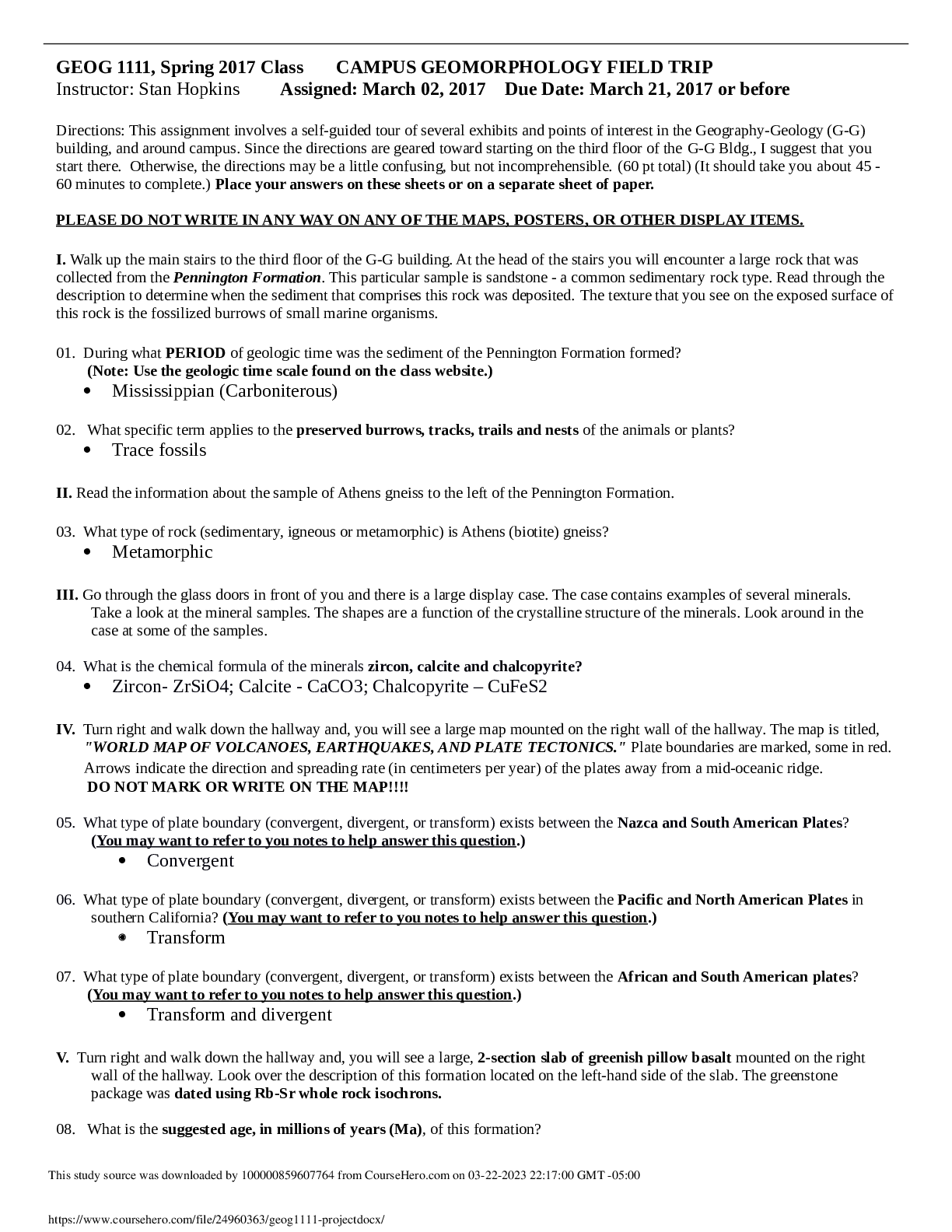
Buy this document to get the full access instantly
Instant Download Access after purchase
Add to cartInstant download
We Accept:

Reviews( 0 )
$8.00
Document information
Connected school, study & course
About the document
Uploaded On
Mar 23, 2023
Number of pages
3
Written in
Additional information
This document has been written for:
Uploaded
Mar 23, 2023
Downloads
0
Views
110

